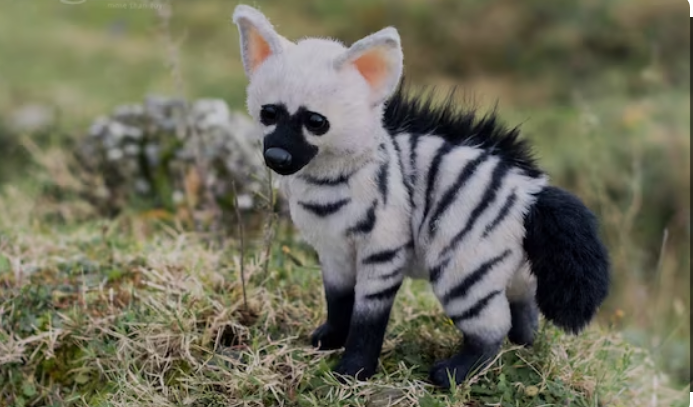Understanding aardwolf: Unraveling the Mysteries of this Unique Species and its Comparison with Hyenas

The animal kingdom is filled with diverse, fascinating creatures, and the aardwolf is no exception. Many people are unfamiliar with this unique species, often confusing it with other members of the hyena family. In this comprehensive guide, we will delve deep into the world of aardwolves, answering prevalent queries like, “How big are hyenas compared to aardwolf?” “Is an aardwolf a predator?” “What is special about the aardwolf?” and “Is a brown hyena the same as an aardwolf?”
Also Read:- Cat Getting Blended Video: Check The Recent Twitter & Reddit Updates Here
Introduction to Aardwolf:
The aardwolf (Proteles cristata) is a small, insectivorous mammal, native to East and Southern Africa. It belongs to the same family as hyenas, called Hyaenidae. However, unlike its larger relatives, the aardwolf primarily consumes termites, making it a unique member of its family. It has a slender, fox-like appearance, distinguishing it from the more robust hyena species.
Size Comparison: Aardwolf and Hyena:
When pondering, “How big are hyenas compared to aardwolf?” it is pivotal to note the significant difference in their sizes. Aardwolves are relatively smaller, weighing around 8-10 kg, whereas spotted hyenas, one of the larger species of hyenas, can weigh between 45-80 kg. Brown hyenas and striped hyenas also exhibit larger sizes compared to aardwolves.
Aardwolf as a Predator:
“Is an aardwolf a predator?” is a question that intrigues many. Technically, the aardwolf is a carnivore, with a diet mainly consisting of termites and other insects. It uses its long, sticky tongue to consume up to 250,000 termites in one night. While it does not hunt large prey like other hyenas, its insectivorous nature technically classifies it as a predator.
Special Features of the Aardwolf:
“What is special about the aardwolf?” The aardwolf is a remarkable creature with several unique features distinguishing it from its hyena relatives. Its specialized diet of termites requires adaptations such as highly developed salivary glands for producing sticky saliva and a specialized digestive system to process its exclusive diet. The aardwolf’s nocturnal nature and solitary lifestyle also set it apart from other hyaenidae members. Its vocalizations, consisting of growls and clucking sounds, are another special characteristic that separates it from the laughing call of the spotted hyena.
Distinction between Brown Hyena and Aardwolf:
Another common query is whether a brown hyena is the same as an aardwolf. Though they share the same family, the aardwolf and the brown hyena (Hyaena brunnea) are distinct species with different ecological niches. Brown hyenas are scavengers, consuming carcasses, while aardwolves predominantly feed on termites. Morphological differences also exist, with brown hyenas having a more robust and larger build compared to the slender aardwolf.
Conservation Status and Habitat:
The aardwolf holds a Least Concern status on the IUCN Red List, with stable populations across its range. It primarily inhabits open, dry plains and bushland, avoiding mountainous terrains. Its habitat preference aligns with the availability of its primary food source, termites. The conservation efforts focusing on the aardwolf involve habitat preservation and maintaining ecological balance to support the existing populations.
Behavioral Aspects and Lifestyle:
Aardwolves lead a primarily nocturnal and solitary existence. They establish territories marked with scent glands and are known to be monogamous creatures, usually forming lifelong bonds with their partners. During the daytime, aardwolves reside in burrows, which could be abandoned aardvark holes or other naturally occurring shelters. Their nocturnal habits and solitary lifestyle help in reducing competition for food within the hyena family.
Contribution to the Ecosystem:
Aardwolves play a crucial role in their ecosystems by controlling termite populations. Their specialized diet helps in maintaining ecological balance, preventing overpopulation of termites, which could otherwise lead to detrimental impacts on vegetation and soil structure.
Conclusion:
The aardwolf is a fascinating and unique creature that resides in the shadow of its larger, more well-known relatives, the hyenas. Its specialized diet, solitary and nocturnal lifestyle, and distinctive morphology separate it from other members of the hyaenidae family. The understanding of the differences between the aardwolf and other hyenas, especially the brown hyena, enriches our knowledge of biodiversity and ecological adaptations. Despite being lesser-known, the aardwolf’s contribution to maintaining ecological balance is indisputable, and its existence is crucial for the well-being of its native ecosystems.
In unraveling the enigma of the aardwolf, we come to appreciate the intricate tapestry of life, where each thread, no matter how seemingly insignificant, plays a pivotal role in maintaining the harmony and balance of the natural world.
Summary:
Explore the fascinating world of the aardwolf, a unique member of the hyaenidae family. Discover its specialized features, compare its size and habits with other hyenas, and understand its indispensable role in maintaining ecological balance within its native habitats.
FAQS
- What is an Aardwolf?
- The aardwolf is a small, insectivorous mammal, native to East and Southern Africa, belonging to the hyena family but primarily consuming termites.
- How big are hyenas compared to an aardwolf?
- Hyenas are significantly larger, with spotted hyenas weighing between 45-80 kg, compared to aardwolves which weigh around 8-10 kg.
- Is an aardwolf a predator?
- Yes, the aardwolf is technically a predator, primarily consuming termites and other insects.
- What is special about the aardwolf?
- The aardwolf is special due to its unique termite-based diet, slender appearance, nocturnal and solitary lifestyle, and its distinctive vocalizations, which are different from other hyenas.
- Is a brown hyena the same as an aardwolf?
- No, a brown hyena and an aardwolf are distinct species with different ecological niches, dietary habits, and physical characteristics within the hyaenidae family








